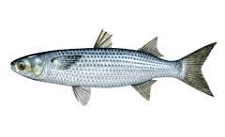Wildlife - Species

Striped Mullet (Mugil cephalus)
Description
Mullet (family Mugilidae) are common inhabitants of freshwater, estuarine and offshore habitats and are well known for their habit of jumping, sometimes up to 1 meter (3 feet), out of the water. Striped mullet, also called grey mullet and black mullet, are elongate with a series of dark stripes that run the length of the body. The dorsal, or upper part of the fish's body, is a bluish-gray color, the underside is white, and there is a purplish blotch on the upper base of the pectoral fins. Similar to other mullets, striped mullet possess a well-developed adipose eyelid, a thick membrane that covers part of the eyeball and presumably functions in protection. Striped mullet have two well-separated dorsal fins (the first one with four spines), pectoral fins that join the fish's body above the midline (towards its back), and no lateral line. The mouth, when viewed from below, appears as an inverted "V."
Preferred Habitat and Biology
This species of mullet is found in temperate and tropical waters throughout the world. Along the western Atlantic, striped mullet are distributed from Brazil to Nova Scotia, including the Caribbean and the Gulf of Mexico. Adult mullet aggregate in large schools and migrate from shallow estuarine areas and freshwater rivers to offshore spawning grounds in the fall and winter. The spawning season for this species is from October to February, with peak activity in November-December. After hatching, larvae remain offshore until they reach about 20 mm (< 1 inch) in length. At this time, they begin migrating back to shallow coastal areas, such as estuaries, where they complete their development. In the fall, young mullet either move to deeper waters or remain in estuaries to spend the winter. Once they become adults, mullet are found in various habitats including freshwater rivers, saltmarshes, estuaries, and the open sea. The feeding habits of striped mullet vary with age. Young mullet feed primarily on small crustaceans and other zooplankton, whereas adults ingest plant matter. They feed by sucking in bottom sediments that contain decaying plant material, algae, and inorganic particles. They may also extract algae and microorganisms from scum that accumulates on the water surface or from the surface of submerged vegetation or other substrates. Swarming marine worms (polychaetes) have also been reported as part of their diet.
Species Significance
Striped mullet have both commercial and recreational value. They are commonly used as bait for favored sport fishes, such as billfish, but they are also a popular food fish in the southeastern United Sates and Gulf coast, where they are sought after for both their meat and their roe (egg mass). The heaviest commercial fishing for mullet is done during spawning migrations, when fish are gathered in large schools near the surface. Gill nets and cast nets are used in the commercial harvest of mullet, whereas recreational fishermen find cast netting to be particularly effective since mullet tend to congregate near the surface.
Striped mullet are neither threatened nor endangered. However, in recent years, the Japanese demand for mullet roe has increased, causing American stocks of this species to decline sharply.
References
Bearden, C.M. 1961. Common marine fishes of South Carolina. Bears Bluff Lab Contribution No. 34. Bears Bluff Laboratory, Inc., Wadmalaw Island, South Carolina.
Boschung, H.T,. Jr., J.D. Williams, D.W. Gotshall, D.K. Caldwell, and M.C. Caldwell. 1983. The Audubon Society field guide to North American fishes, whales and dolphins. Alfred A. Knopf, New York, NY.
Collins, M.R. 1985. Species profiles: Life histories and environmental requirements of coastal fishes and invertebrates (South Florida) - striped mullet. Biological Report 82(11.34). U.S. Fish and Wildlife Service, Washington, DC.
Murdy, E.O., R.S. Birdsong, and J.A. Musick. 1997. Fishes of the Chesapeake Bay. Smithsonian Institution Press, Washington, DC.
